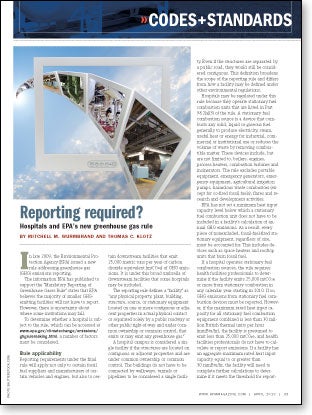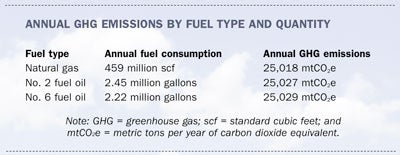Reporting required?
 In late 2009, the Environmental Protection Agency (EPA) issued a new rule addressing greenhouse gas (GHG) emissions reporting.
In late 2009, the Environmental Protection Agency (EPA) issued a new rule addressing greenhouse gas (GHG) emissions reporting.
The information EPA has published to support the "Mandatory Reporting of Greenhouse Gases Rule" states that EPA believes the majority of smaller GHG-emitting facilities will not have to report. However, there is uncertainty about where some institutions may fall.
To determine whether a hospital is subject to the rule, which can be accessed by clicking here, a number of factors must be considered.
Rule applicability
Reporting requirements under the final rule will apply not only to certain fossil fuel suppliers and manufacturers of certain vehicles and engines, but also to certain downstream facilities that emit 25,000 metric tons per year of carbon dioxide equivalent (mtCO2e) of GHG emissions. It is under this broad umbrella of downstream facilities that some hospitals may be included.
The reporting rule defines a "facility" as "any physical property, plant, building, structure, source, or stationary equipment located on one or more contiguous or adjacent properties in actual physical contact or separated solely by a public roadway or other public right-of-way and under common ownership or common control, that emits or may emit any greenhouse gas."
A hospital campus is considered a single facility if the structures are located on contiguous or adjacent properties and are under common ownership or common control. The buildings do not have to be connected by walkways, tunnels or pipelines to be considered a single facility. Even if the structures are separated by a public road, they would still be considered contiguous. This definition broadens the scope of the reporting rule and differs from how a facility may be defined under other environmental regulations.
Hospitals may be regulated under this rule because they operate stationary fuel combustion units that are listed in Part 98.2(a)(3) of the rule. A stationary fuel combustion source is a device that combusts any solid, liquid or gaseous fuel generally to produce electricity, steam, useful heat or energy for industrial, commercial or institutional use or reduces the volume of waste by removing combus¬?tible matter. These devices include, but are not limited to, boilers, engines, process heaters, combustion turbines and incinerators. The rule excludes portable equipment, emergency generators, emergency equipment, agricultural irrigation pumps, hazardous waste combustors (except for co-fired fossil fuels), flares and research and development activities.
EPA has not set a minimum heat input capacity level below which a stationary fuel combustion unit does not have to be included in a facility's calculation of annual GHG emissions. As a result, every piece of nonexcluded, fossil-fuel-fired stationary equipment, regardless of size, must be accounted for. This includes devices such as space heaters and rooftop units that burn fossil fuel.
If a hospital operates stationary fuel combustion sources, the rule requires health facilities professionals to determine if the facility emits 25,000 mtCO2e or more from stationary combustion in any calendar year starting in 2010. If so, GHG emissions from stationary fuel combustion devices must be reported. However, if the maximum rated heat input capacity for all stationary fuel combustion equipment combined is less than 30 million British thermal units per hour (mmBtu/hr), the facility is presumed to emit less than 25,000 mtCO2e, and health facilities professionals do not have to calculate or report emissions. If a facility has an aggregate maximum rated heat input capacity equal to or greater than 30 mmBtu/hr, the facility will need to complete further calculations to determine if it meets the threshold for reporting.
It is likely that many hospitals exceed this 30 mmBtu/hr threshold. Those facilities will, at a minimum, need to calculate their historical annual mtCO2e emissions to see if the facility can be expected to exceed the GHG reporting threshold.
Estimating and reporting
For facilities that exceed the 25,000 mtCO2e reporting threshold, facilities professionals must report annual emissions of carbon dioxide (CO2), methane (CH4) and nitrous oxide (N2O) for each fuel combusted.
EPA has prescribed specific calculation methodologies within the reporting rule for estimating emissions. To address the proper level of reporting rigor, EPA developed four calculation options, or tiers, that may be selected based on combustion unit size, type of fuel burned and other factors.
For example, Tier 1 represents a simplified calculation methodology where company records may be used to determine fuel use and default emissions factors, and fuel high heating values may be used to estimate emissions. Tier 4 methodology presents the opposite end of the spectrum and requires a continuous emission monitoring system (CEMS) for estimating emissions from certain units. Tiers 2 and 3 use combinations of the simplified and complex approaches.
Generally, all combustion units with a rated heat input capacity of 250 mmBtu/hr or less are allowed to use the simpler Tier 1 or Tier 2 calculation methodologies. Certain combustion units with input ratings above 250 mmBtu/hr that combust pipeline quality natural gas and distillate oil are also allowed to use Tier 2. However, units rated above 250 mmBtu/hr that combust residual oil, other gaseous fuels, and solid fossil fuels will need to apply the Tier 3 or Tier 4 methodologies.
Depending upon the chosen method, some facilities will need to comply with requirements for conducting fuel sampling and analysis, and installing/calibrating monitoring devices (e.g., fuel flow meters). It is likely that most hospitals will be able to use Tier 1 or Tier 2 calculation methodologies.
As an option, EPA will allow many facilities to aggregate emissions reporting from individual units with maximum rated heat input capacities less than 250 mmBtu/hr. Units may also be aggregated based on the use of a common fuel supply line or pipe or a common stack or duct configuration where CEMS are used.
While this may provide some relief for many reporting facilities, there are a few particularly burdensome requirements that remain, including the obligation to report an identification number for each combustion unit reported in a group and the cumulative maximum rated heat input capacity of the group (mmBtu/hr).
Consequently, regardless of whether a health facility elects to report by individual unit or multiple units aggregated by group, the facility will likely need to prepare a comprehensive stationary fuel combustion equipment inventory for all nonexcluded combustion units. The development of a combustion equipment inventory could be complicated for facilities that employ the use of many smaller combustion units.
One particularly time-sensitive requirement within the reporting rule is the written GHG monitoring plan, which affected facilities are required to have in place this month. The monitoring plan is expected to identify individuals responsible for the collection of emissions data; explain the methods used to collect data and perform emission calculations; and describe the procedures used for quality assurance, maintenance and repair of monitors and other instrumentation.
The plan may rely on references to existing documents (e.g., standard operating procedures and quality assurance programs) and, as such, EPA has not prescribed a specific format. Facilities are not required to submit the monitoring plan to EPA for approval, but must retain the plan in accordance with the record-keeping requirements.
Other key aspects
There are a number of general provisions and other key aspects that should be carefully considered by reporting facilities. They include the following:
• Facilities subject to reporting should have initiated data collection and recordkeeping activities on Jan. 1, 2010.
• The first annual GHG report is due March 31, 2011.
• Records must be retained for at least three years.
• Records must be available to EPA for review upon request.
• A single individual should be made responsible for certifying, signing and submitting GHG emission reports.
• Revisions to a report submitted to EPA must be provided within 45 days of discovery or notification by EPA.
Once a health facility is subject to the reporting rule, it must continue to report each subsequent year, even if the facility does not exceed thresholds during future reporting years. EPA allows facilities to cease reporting after five consecutive years if reported emissions are less than 25,000 mtCO2e or after three consecutive years if reported emissions are less than 15,000 mtCO2e.
Additionally, EPA reserves the option to verify the completeness and accuracy of GHG emissions reports and may take enforcement action for any violation of a reporting rule requirement. GHG regulatory enforcement likely will be a high priority of the EPA in the short term.
Evaluating responsibility
Health facilities professionals will need to evaluate their responsibilities under EPA's GHG reporting rule.
It may be that many smaller hospitals will not have to report their GHG emissions to EPA. It is also likely, however, that most hospitals will need to calculate their emissions to document them.
Mitchell M. Wurmbrand is an associate principal and certified consulting meteorologist in the Bloomfield, Conn., office of Norwood, Mass.-based GZA GeoEnvironmental Inc. His e-mail is Mitchell.Wurmbrand@gza.com. Thomas C. Klotz is a project manager in GZA's Livonia, Mich., office. His e-mail is Thomas.Klotz@gza.com. The opinions expressed in the article are the authors' own.
| Sidebar - Origins of the GHG reporting rule |
| Hidden away in the fiscal year 2008 Consolidated Appropriations Act was a provision for the Environmental Protection Agency (EPA) to develop a rule "to require mandatory reporting of greenhouse gas (GHG) emissions above appropriate thresholds in all sectors of the economy of the United States." In April 2009, EPA proposed the "Mandatory Reporting of Greenhouse Gases Rule." The purpose of the rule is to provide EPA with the data it will need to make future policy decisions regarding GHGs and climate change. During the official 60-day comment period and beyond, the EPA held public hearings, received nearly 17,000 written comments, met with 4,000 individuals and 135 groups. A little over five months after publishing the proposed rule, the EPA issued its final rule on mandatory GHG reporting. The rule was then published in the Federal Register on Oct. 30, 2009, and went into effect 60 days later. |
| Sidebar - Checking facility applicability |
| If a health care facility operates stationary fuel combustion sources that, in the aggregate, exceed 30 million British thermal units per hour heat input capacity, the table below provides a rule of thumb for how much fuel must be consumed on an annual basis to exceed 25,000 metric tons per year of carbon dioxide equivalent.
|





